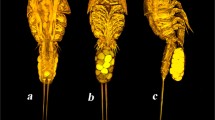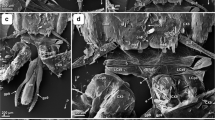Abstract
Integumental pore signatures supplemented by routine morphological characters were studied in the females of five species of Thermocyclops Kiefer, 1927. Both techniques reveal structures with potential significance to taxonomy. Examples of these include a protruding spine of the sixth antennular segment, and a big opening near the genital pore. Bilaterally symmetrical, species-specific pore groups are found on the cephalosome, metasome and urosome, while conserved pores exist on the rostrum, on well-defined zones of the cephalosome, metasome, urosome and on the furcal rami. Exceptionally, asymmetry in these pore patterns may occur.
Similar content being viewed by others
References
Baribwegure, D., 2003. Revision of the genus Thermocyclops Kiefer, 1927 by integumental pore mapping and a comparison with some other cyclopoid genera. PhD dissertation. Department of Biology, Faculty of Sciences, University of Ghent, Belgium.
Baribwegure, D. & H. J. Dumont, 1999. The use of integumental pore signature in the characterisation of species of the genus Thermocyclops Kiefer, 1927: the case of Thermocyclops emini (Mrázek, 1895) (Crustacea: Copepoda: Cyclopoida). Belg. J. Zool. 129: 187–200.
Baribwegure, D., C. Thirion & H. J. Dumont, 2001. The integumental pore signature of Thermocyclops oblongatus (Sars, 1927) and Thermocyclops neglectus (Sars, 1909), with the description of Thermocyclops africae new species, and a comparison with Thermocyclops emini (Mrázek, 1895). Hydrobiologia 458: 201–220.
Dumont, H. J., 1966. Scapholeberis aurita (S. Fischer, 1849) Hellich, 1877 (Crustacea: Cladocera) en Thermocyclops dybowskii (Landé, 1890) Kiefer, 1927 (Crustacea: Copepoda) in België. Biol. Jrb. Dodonaea 34: 85–93.
Dumont, H. J. & W. Decraemer, 1977. On the continental copepod fauna of Morocco. Hydrobiologia 52: 257–278.
Dumont, H. J., P. Laureys & J. Pensaert, 1979. Anostraca, Conchostraca, Cladocera and Copepoda from Tunisia. Hydrobiologia 66: 259–274.
Dussart, H. B. & R. Gras, 1966. Faune Planctonique du Lac Tchad. Cah. ORSTOM, Sér. Océanogr. 4: 77–91.
Einsle, U., 1970. Etudes morphologiques sur des espèces du genre Thermocyclops (Crust. Cop.) d'Afrique et d'Europe. Cah. ORSTOM 4: 13–38.
Fiers, F. J., W. Reid, T. M. Iliffe & E. Suárez-Morales, 1996. New hypogean cyclopoid (Crustacea) from the Yucatán Peninsula, Mexico. Contributions to zoology 66: 65–102.
Fiers, F. & I. Van de Velde, 1984. Morphology of the antenna and its importance in the systematics of the Cyclopidae. Crustaceana 7: 182–199.
Fleminger, A., 1973. Pattern, number, variability, and taxonomic significance of integumental organs (Sensilla and Glandular Pores) in the genus Eucalanus (Copepoda, Calanoida). Fish. Bull. U.S. 71: 965–1010.
Galassi, D. M. P., P. De Laurentiis & M. Giammatteo, 1998. Integumental morphology in copepods: assessment by confocal laser scanning microscopy (CLSM). Fragm. Entom. Roma 30: 79–92.
Herbst, H-V., 1986. Beschreibung des Thermocyclops hastatus antillensis n. ssp. Mit einem bestimmungsschlussel fur die gattung Thermocylops Kiefer, 1927. Bijdr. Dierk. 56: 165–180.
Holynska, M. & F. Fiers, 1994. Mesocyclops thermocyclopoides species-group: redefinition and content. Hydrobiologia 292/293: 41–51.
Huys, R. & G. A. Boxshall, 1991. Copepod Evolution. The Ray Society, London. 468 pp.
Park, J.S., S. P. & J Mauchline, 1994. Evaluation of integumental pore signatures of species of calanoid copepods (Crustacea) for interpreting inter-species relationships. Mar. Biol. 120: 107–114.
Kiefer, F., 1926. Diagnosen neuer Suwasser-Copepoden aus Afrika. Zool. Anz. 66: 263–268.
Koomen, P., 1992. The integumental perforation pattern of the Euchirella messinensis Female (Copepoda, Calanoida): corrections, additions, intraspecific variation, and a checklist of pores sites. Crustaceana 63: 113–159.
Lajus, D., 2000. Components of morphological variation in Baikalian endemial cyclopid Acanthocyclops signifer complex from different localities. Hydrobiologia 417: 25–35.
Lens, P., 1978. Studie van de Crustacea Entomostraca van Mount Kenya. Thesis. Rijksuniversiteit Gent, Faculteit Wetenschappen. 107 pp.
Löffler, H.,1968. Die Crustaceenfauna Ostafrikas. Hochgebirgsforschung. 1: 1–68.
Maas, S., 1982. Morfologische Studie van Enkele Thermocyclopssoorten uit Afrika. Thesis. Rijksuniversiteit Gent, Faculteit Wetenschappen. 106 pp.
Malt, S. J., 1983. Polymorphism and pore signature patterns in the copepod genus Oncaea (Cyclopoida). J. mar. biol. Ass. U.K. 63: 449–466.
Mauchline, J., 1977. The integumental sensilla and glands of pelagic crustacea. J. mar. biol. Ass. U.K. 57: 973–994.
Mauchline, J., 1987. Taxonomic value of pore pattern in the integument of calanoid copepods (Crustacea). J. Zool. Lond. 214: 697–749.
Mauchline, J. & T. Nemoto, 1977. The occurrence of integumental organs in copepodid stages of calanoid copepods. Bull. plankt. Soc. Japan 24: 108–114.
Ohtsuka, S. & C. Mitsuzumi, 1990. A new symmetrical near-bottom calanoid copepod, Paramisophria platysoma, with observations of its integumental organs, behavior and in-situ feeding habit. Bull. plankt. Soc. Japan 36: 87–101.
Rocha, C. E. F., 1994. New species of Metacyclops (Copepoda, Cyclopidae) from Brazil, with remarks on M. campestris. Zool. scr. 23: 133–146.
Rocha, C. E. F., 1998. New morphological characters useful for the taxonomy of the genus Microcyclops (Copepoda, Cyclopoida). J. mar. Syst. 15: 425–431.
Samraoui, B., H. Segers, S. Maas, D. Baribwegure & H. J. Dumont, 1998. Rotifera, cladocera, copepoda, and ostracoda from coastal wetlands in northeast Algeria. Hydrobiologia 386: 183–193.
Van de Velde, I., 1984. Revision of the African species of the genus Mesocyclops Sars, 1914 (Copepoda: Cyclopidae). Hydrobiologia 109: 3–66.
Author information
Authors and Affiliations
Rights and permissions
About this article
Cite this article
Baribwegure, D., Dumont, H. The integumental pore signature of Thermocyclops schmeili (Poppe & Mrázek, 1895); Thermocyclops dybowskii(Landé, 1890); Thermocyclops hooki Löffler, 1968; Thermocyclops incisus Kiefer, 1932 and Thermocyclops inopinus (Kiefer, 1926). Hydrobiologia 505, 15–30 (2003). https://doi.org/10.1023/B:HYDR.0000007216.58971.38
Issue Date:
DOI: https://doi.org/10.1023/B:HYDR.0000007216.58971.38




